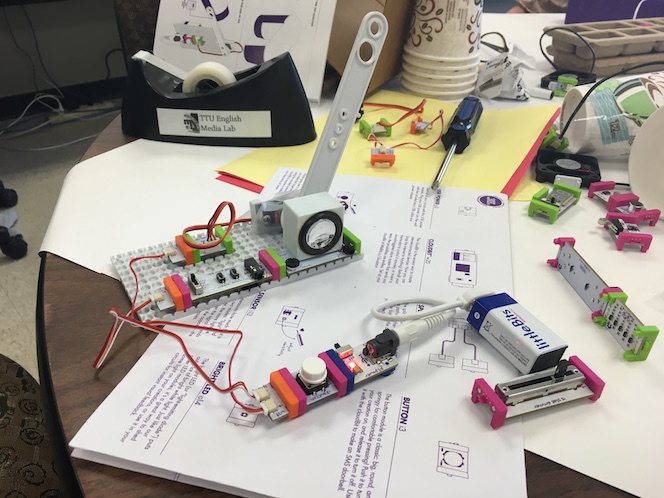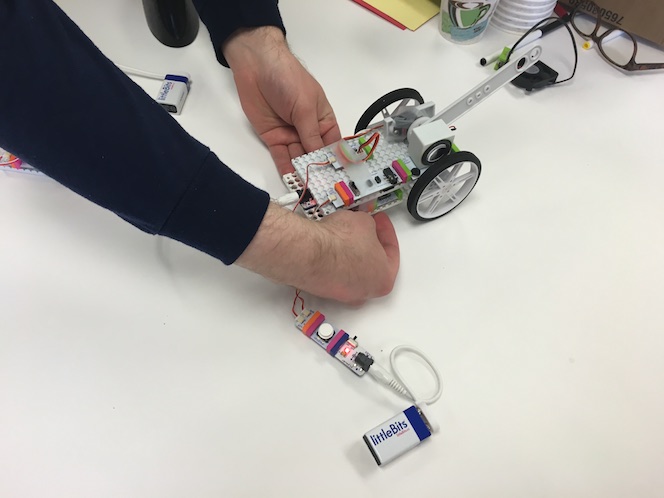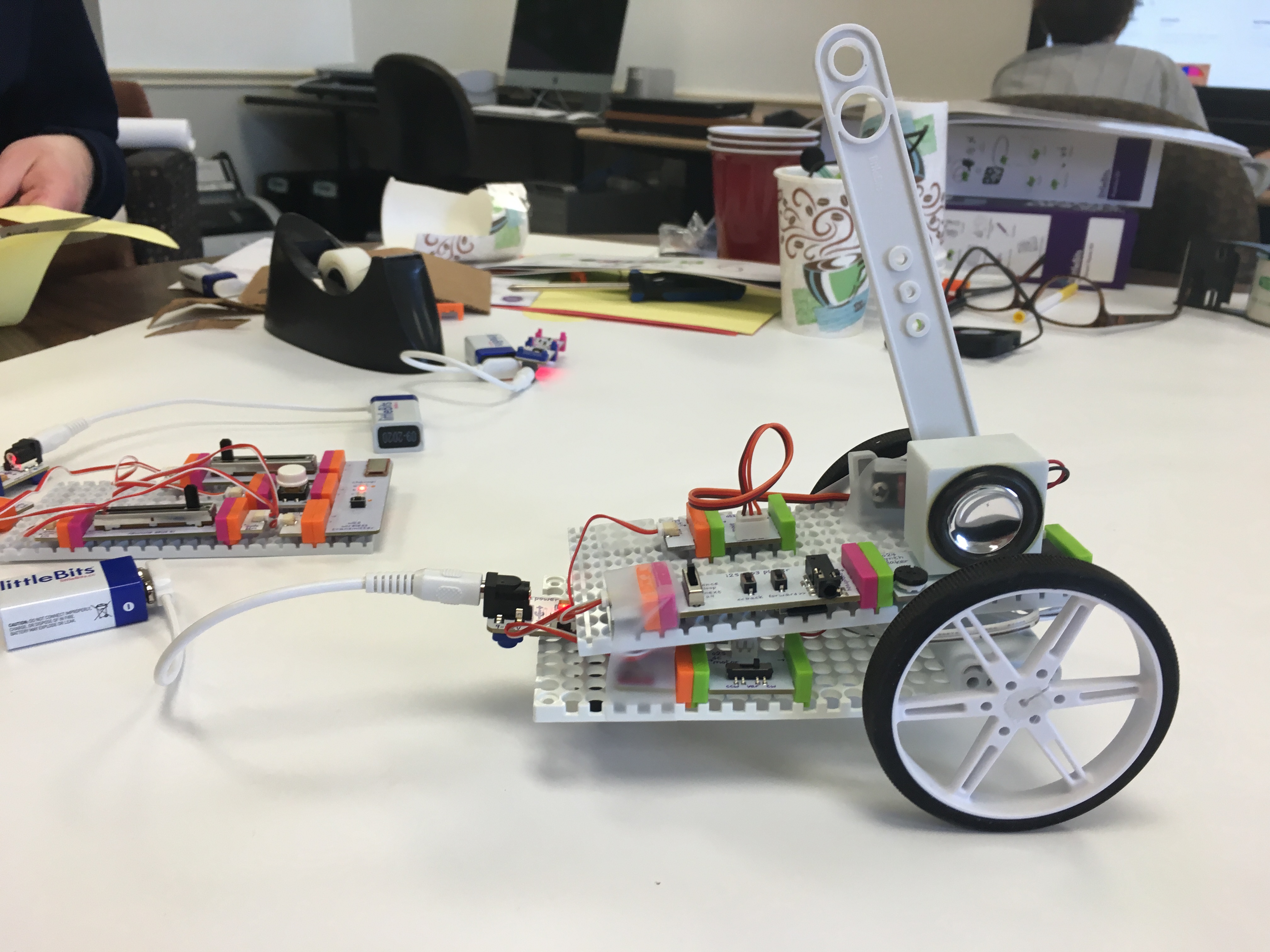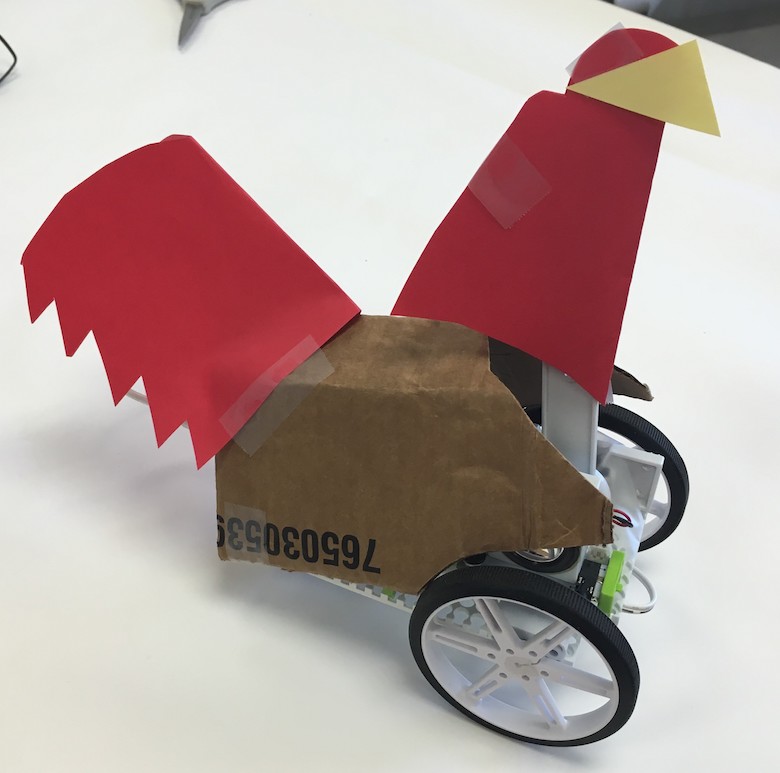Creating with littleBits: Remixing, Assembling, and Crafting
After building a foundation through experimentation and play, our group decided to continue our invention process by creating more complex mechanical objects. As we grew more knowledgeable about littleBits and collaborated on the design and development of our ideas, our products became more advanced and more innovative. Our overall goal for this portion of our invention process was to move from simply playing and experimenting to a more defined play, in which we created a new, unique construction. In this section, we share our experiences creating a mechanical chicken, exploring how our creation process was one of remixing, assembling, and crafting. Recognizing that constructing a chicken out of littleBits would be a challenging task, we decided to focus on a few simple characteristics of a real chicken: its ability to move, cluck, and peck.
Our assemblage process involved understanding both littleBits modules and other available objects (e.g., construction paper, tape, MP3s) as material commonplaces that were "around, on hand" (Sirc, 2002, p. 44). Following composition scholars like Geoffrey Sirc (2002) and Johndan Johnson-Eilola and Stuart Selber (2007), we understand craft as a matter of "filtering, recombining, remixing, and making of assemblages" (Johnson-Eilola & Selber, 2007, p. 400). While Johnson-Eilola and Selber were interested in "assemblages that solve problems" (p. 400), admittedly, our robotic chicken does little to solve a problem. In making a chicken, we were a bit playful in our craftwork, rather than pragmatically addressing a real-world problem. In this way, we followed Sirc (2002) in understanding composition as artful assemblages that remix material commonplaces, attempting to discover a "buzz" or "wow" (pp. 50, 51). But we also hope that by providing this example, we are suggestive of possibilities for problem-solving with maker rhetoric.
We began our creation process by identifying what we had already constructed: a robotic throwing arm, a remote control car, a fan, a light, and a writing machine. Considering each component carefully, then thinking about how we could combine them, we discussed possible constructions and methods of creating a collage of our works. During this process, we attempted to remix some of our constructions, to create new, simple machines. For example, combining the fan with the lights, testing the different switches and control features, and experimenting with the number of devices that could be powered by a single battery.
The idea that appealed to everyone for our assemblage was creating a mechanical chicken. The chicken presented a few distinct challenges: It was something new and unique that we had not yet built; it incorporated littleBits pieces that we hadn't yet used; and it combined our team's developing expertise. Ultimately, this project also presented a fun, new challenge for exploration. We believed that with our experiences creating the car and the throwing arm, we would have the foundation to combine these machines with new ideas, remixing our old creations into a new assemblage. We began with carefully disassembling our other constructions, ensuring that the core components of the chicken were maintained and that we had the bits needed to proceed. In order to bring forth the ideas and principles that we applied during our play, we continued to experiment with new modules, specifically the sound module, locating a chicken-clucking MP3 file, and providing multiple power sources to ensure that our chicken would work. We added new buttons to the remote control transmitter and to the receiver, located on the body of the chicken, to allow us to enable the pecking and clucking actions at a distance.


This project tested our planning and collaboration skills. We each took different roles as we planned and constructed the chicken: Jack focused on preparing the remote control, ensuring that everything functioned properly; Leslie and Jamie worked on assembling the chicken itself, including locating recyclables to create the body; and Andrew worked on the audio components. As the project progressed, we rotated roles, all taking turns working on the chicken, experimenting with the different features, and working with our teammates to better understand how each of the littleBits components functioned.

Many of the challenges and failures that we had experienced earlier, such as the poor connections between some of the littleBits components (see our discussion of the tinkerer's approach), plagued this project as well. However, as we learned through our play, we expected these issues and were able to remedy this through the extensive use of tape and by paying careful attention to our construction. We built off of the strengths of individual team members: Each team member had either constructed a component of the chicken or had ideas that contributed to the final project, enabling us to work collaboratively and ensure that everyone took a role in the project. The group assemblage of the chicken was not only challenging, but presented us with a unique opportunity to play and have fun with our experience. We were able to build strong connections to our work and to each other and truly were able to enjoy our experience.
As a team, we laughed at the failures, then worked diligently to find solutions. Below is a video that demonstrates a phase of our testing process. As we have described earlier, the poor connections between some of the littleBits components resulted in very weak constructions. Despite our efforts to assemble the chicken in an manner that was secure, the device would simply collapse. As we had finished the chicken and were testing, the wheels came loose, resulting in the chicken coming apart. Our solution, after making fun of the chicken: More tape!

As we have discussed, the chicken provided us with an opportunity to hone our craft and to create a new assemblage out of our various littleBits inventions. We also were able to incorporate different media, such as paper and tape, to enhance our creation. Our mechanical collage allowed us to create a space to experiment with our assemblage, and to test our craft, building something new and unique from discrete components. We embraced and expected failure, understanding it as a critical component to our invention process, treating it as a necessary stage in the development process.
Packing Up: Assemblages as Craft
As we were simultaneously developing instructional materials with our project, we followed Johnson-Eilola and Selber's (2007) advice: "We want teachers to start seeing assemblages as a valid and valued form of student writing—and of writing in general" (p. 380). We took our constructions, our experiences, and our imaginations and were able to break them down and reassemble them into a new creation, something that carried forward each of the individual pieces while presenting them in a new form, in a new idea. Through play and exploration, we reaffirmed our understanding of the remixing, assembling, and crafting process. Below is a video we produced for the Media Lab sharing our invention. In the video, we use the song "Chicken" by Other Things (2015).
Through the process of assembling a chicken, we engaged in playful craft. As Richard Sennett (2008) has explained, craftwork necessarily involves play, because it is in the process of play that individuals are "learning how to make a practice better" (p. 271). We turn to craft more explicitly in our discussion of disrupting with littleBits.